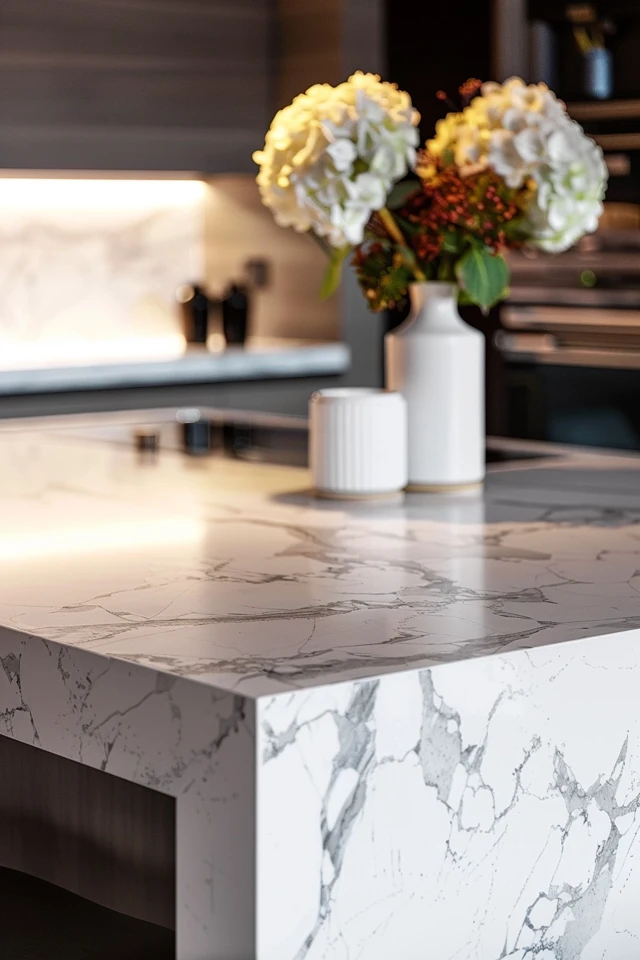Marble countertops are a stunning addition to any kitchen or bathroom, offering a timeless beauty that enhances the overall aesthetic of the space. However, to keep your marble counters looking their best, proper maintenance and care are essential. In this guide, I will share valuable preservation strategies and tips for caring for your marble surfaces, ensuring they remain beautiful for years to come.
Key Takeaways:
- Regular cleaning with a gentle, non-abrasive dish soap and warm water is crucial for marble countertop upkeep.
- Avoid using harsh chemicals or acidic cleaners that can cause damage to the surface of the marble.
- Sealing marble periodically helps protect against stains and maintains its natural luster.
- Immediate attention to spills, especially acidic substances, prevents potential staining and etching.
- Identifying marble characteristics and clearing the surface of debris are essential initial cleaning steps.
Essential Care Tips for Marble Countertop Maintenance
Proper care is crucial for maintaining the luxurious finish of marble countertops. By following these essential care tips, you can ensure that your marble surfaces remain beautiful and pristine for years to come.
Routine Cleaning
To keep your marble countertops clean and free from everyday grime and spills, a simple routine cleaning method is highly recommended. Mix a gentle, non-abrasive dish soap with warm water and use a soft microfiber cloth or sponge to wipe down the surface. Rinse the cloth or sponge frequently to avoid redistributing dirt. After cleaning, make sure to thoroughly dry the marble to prevent water spots.
It’s important to note that you should avoid using harsh chemicals or acidic cleaners on marble, as they can damage the surface and cause etching. Instead, opt for mild and pH-neutral cleaning solutions to protect the marble’s natural beauty.
Sealing Marble
Marble is a porous material, which means it can easily absorb liquids and stains. To protect against potential staining, it’s important to seal your marble countertops regularly. The frequency of sealing depends on the specific type of marble and the level of use it experiences.
Sealing helps create a protective barrier on the surface of the marble, preventing liquids from penetrating and causing stains. You can find various marble sealers on the market, and it’s advisable to follow the manufacturer’s instructions for application.

Preventing Stains and Etching
While sealing provides an additional layer of protection, it’s still important to be proactive in preventing stains and etching on your marble countertops. Whenever spills occur, especially those involving acidic substances like citrus juices or vinegar, it is crucial to wipe them up immediately. Acidic substances can quickly etch the marble surface and leave permanent marks.
Using coasters and trivets for hot objects, such as pots and pans, can also help prevent heat-related damage. Placing cutting boards or mats on the marble surface when preparing food can protect against scratching and cutting marks.
“Regular upkeep and careful cleaning practices are key to maintaining the natural beauty of marble countertops.”
Regular Upkeep
In addition to routine cleaning and sealing, regular upkeep is essential for preserving the beauty of your marble countertops. This includes regular dusting to remove any surface debris and avoiding abrasive scrubbing or scouring pads that can scratch the marble. When dealing with stubborn stains, it’s best to consult with a professional marble cleaning and restoration specialist to ensure proper treatment.
By incorporating these essential care tips into your marble countertop maintenance routine, you can enjoy the timeless elegance of marble for years to come.

Identifying Marble Characteristics and Initial Cleaning Steps
Before we delve into the essential maintenance and care practices for marble countertops, it’s crucial to understand the composition and quality of this magnificent natural stone. Marble is primarily composed of calcium carbonate and is formed through the metamorphism of limestone, resulting in its unique beauty and veining patterns.
One key characteristic of marble is its porous nature, with small pores that can absorb liquids and stains if not properly protected. To assess the quality of marble, look for even color distribution, a smooth finish, and the absence of excessive veining or irregularities. These features are indicative of high-quality marble that is more resistant to damage.
When it comes to initial cleaning and preparation, it’s important to start with a clear surface. Remove any debris or particles using a soft cloth or a vacuum cleaner with a brush attachment. This ensures a clean base for thorough assessment.
Next, examine the surface for any stains or etching. Stains can occur when liquids such as wine, coffee, or oil penetrate the marble and leave discoloration. Etching, on the other hand, refers to the dulling or whitening of the surface due to the corrosive action of acidic substances. Identifying these issues early on allows for targeted treatment and protection.


